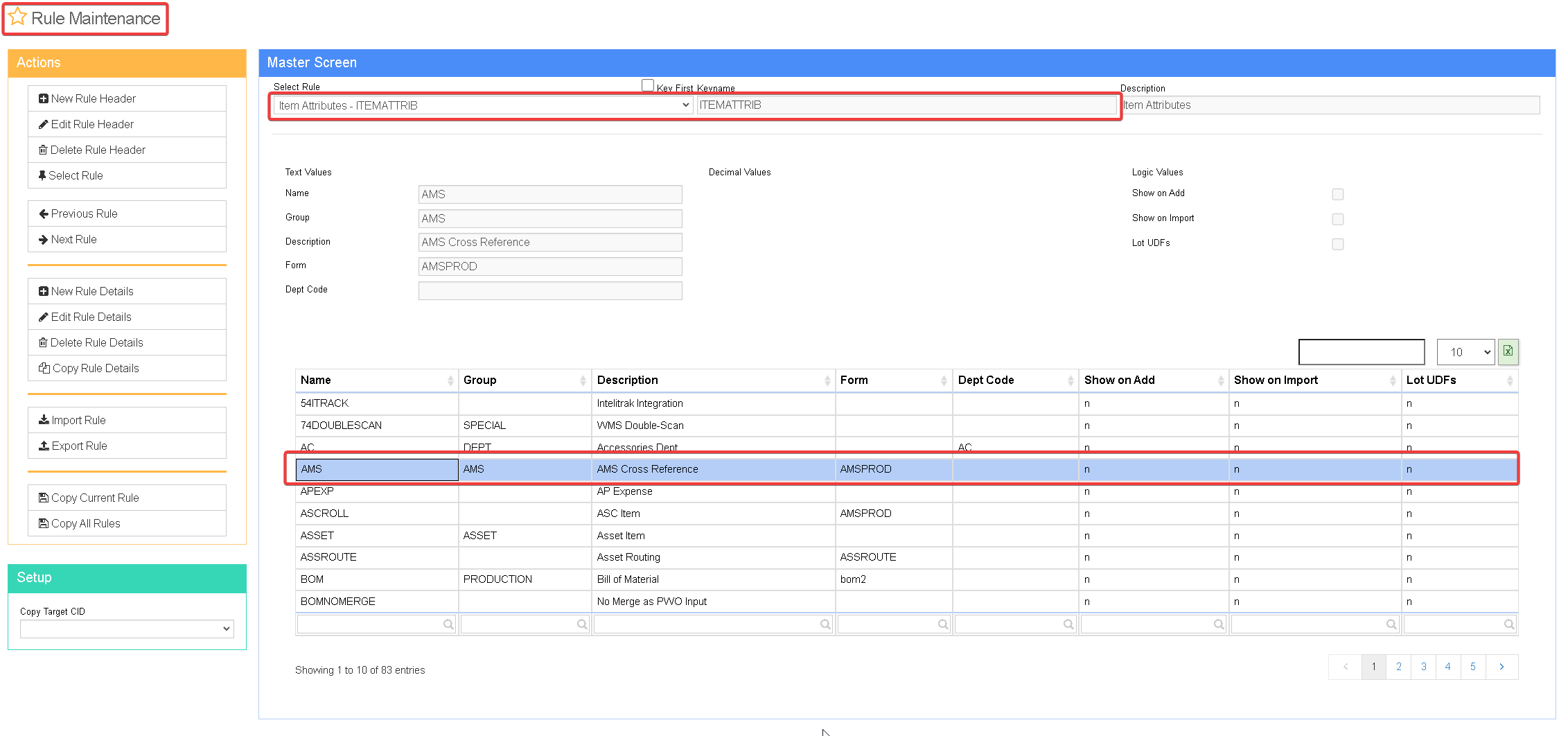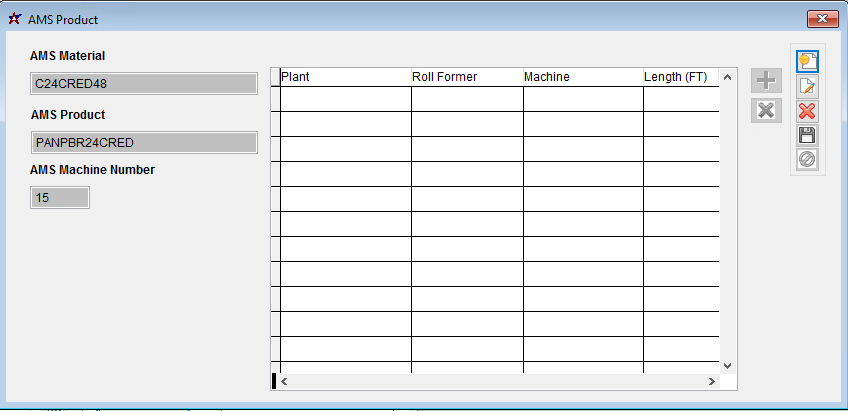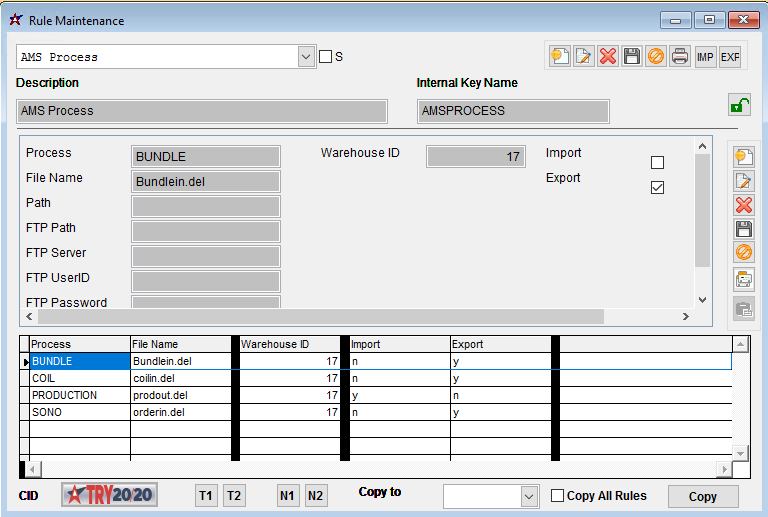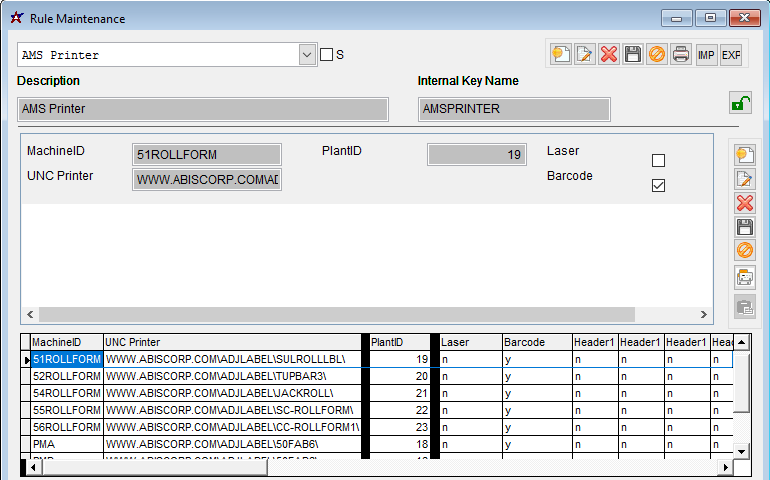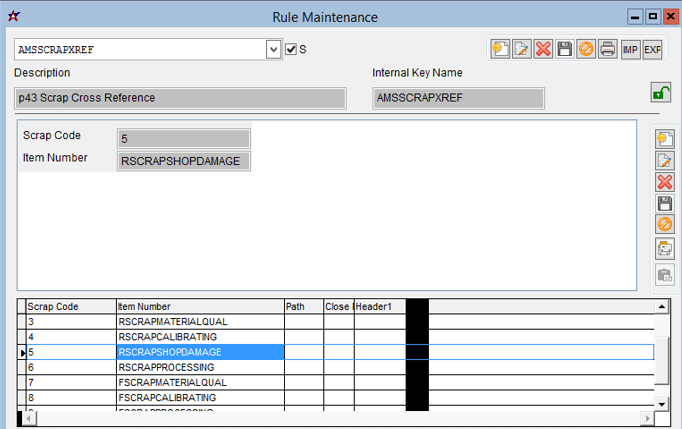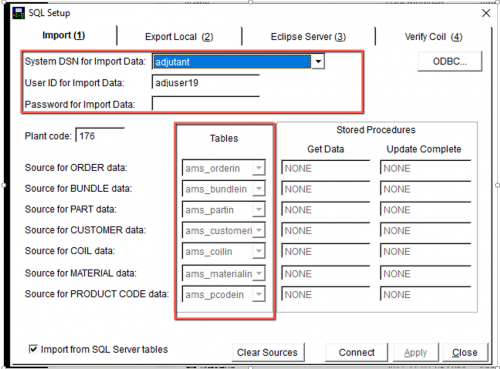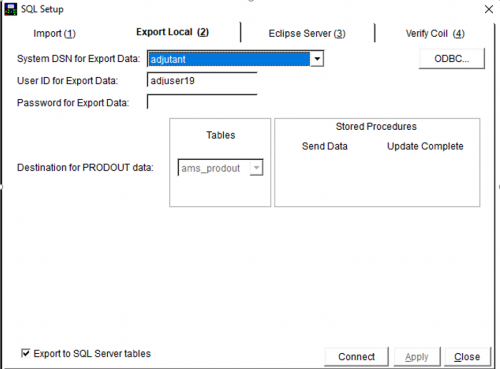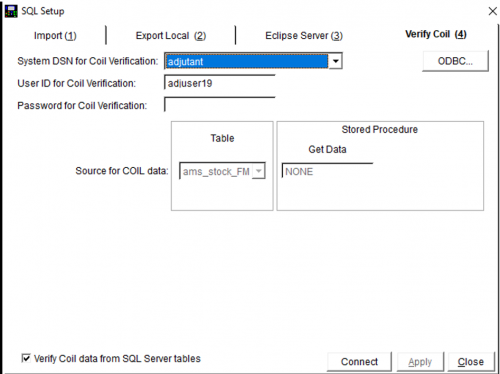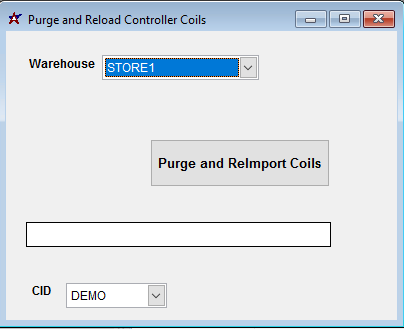Difference between revisions of "AMS Setup"
From Adjutant Wiki
(→Item Attributes) |
|||
| (30 intermediate revisions by 4 users not shown) | |||
| Line 9: | Line 9: | ||
This set up assumes a hosted connection, though non-hosted connections have a similar and at times identical setup. | This set up assumes a hosted connection, though non-hosted connections have a similar and at times identical setup. | ||
| + | |||
| + | AMS Integration runs off of a service called AdjAmsProcess.exe. | ||
| + | |||
==Initial Set Up== | ==Initial Set Up== | ||
| − | Eclipse uses what is called "On Demand" coil verification. This means when a user scans a coil, they call back a special database table that has all the right information in place. This means that David will need to create new AMS specific data tables. These tables will be matched up in the Eclipse screen below. Sending the following email to support@abiscorp.com should make the ticket you need. Be sure to replace your customer name, custno, and resource ID in the tag and body below. | + | There are a number of things that can and should be set up before you are ready to "flip the switch". The Database Set Up section, the Item Attributes section, and the Rule Setup sections should all be completed before working with Eclipse for the integration. |
| + | |||
| + | Once you are ready to "flip the switch", you will complete the Eclipse Setup section, then the Setup Options section, then the Coil Table Population section, then the Ready to Test section. This set up needs to be done all at once, so be sure you budget your time to get each of these done and troubleshoot if needed. | ||
| + | |||
| + | |||
| + | ===Database Set Up=== | ||
| + | |||
| + | Eclipse uses what is called "On Demand" coil verification. This means when a user scans a coil, they call back a special database table that has all the right information in place. This means that David will need to create new AMS specific data tables. These tables will be matched up in the Eclipse screen below. Typically the tables are named AMS_*** where the *** will match the Eclipse name. For the On Demand coil table, David will typically name the view AMS_STOCK_WhseName | ||
| + | |||
| + | Sending the following email to support@abiscorp.com should make the ticket you need. Be sure to replace your customer name, custno, and resource ID in the tag and body below. | ||
''Please create the AMS tables needed for Eclipse integration on [your customer's] system. '' | ''Please create the AMS tables needed for Eclipse integration on [your customer's] system. '' | ||
| Line 24: | Line 36: | ||
''priority[p2]'' | ''priority[p2]'' | ||
| − | ==Item Attributes== | + | |
| + | ===Item Attributes=== | ||
For Adjutant to recognize and push an item out to Eclipse, it needs to have the proper item attribute (Attribute name "AMS" with form "AMSPROD" in the Item Attribute Rule). | For Adjutant to recognize and push an item out to Eclipse, it needs to have the proper item attribute (Attribute name "AMS" with form "AMSPROD" in the Item Attribute Rule). | ||
| − | [[ | + | [[image:amsrule.png]] |
| − | The Attribute jump screen has three fields. These fields will need to line up with the Eclipse data exactly. The preferred scenario is that | + | The AMS Product Attribute jump screen has three fields. These fields will need to line up with the Eclipse data exactly. The preferred scenario is that the customer sets up their Eclipse items with the same names as their item codes in Adjutant. That makes for an easy data import. This information can be filled out using an Excel import (download here) and shows data from the AMSXREF table. |
| − | |||
| − | |||
* AMS Material: This is the material as AMS understands it to use make this item. Similar to the BOM material in Adjutant. | * AMS Material: This is the material as AMS understands it to use make this item. Similar to the BOM material in Adjutant. | ||
| Line 40: | Line 51: | ||
Please note that any item and material that is interacting with AMS/Eclipse will need this attribute. This means that every coil will have the attribute with '''only''' the Material section filled out. Adjutant will remove the other fields and recognize it as material. | Please note that any item and material that is interacting with AMS/Eclipse will need this attribute. This means that every coil will have the attribute with '''only''' the Material section filled out. Adjutant will remove the other fields and recognize it as material. | ||
| + | |||
| + | For a more detailed run through of the AMS Xref Import, [http://www.abiscorp.com/faq/index.php?title=AMS_Cross-Reference_Import_Guide See this guide] | ||
[[File:AMS Wiki AMS Attribute Jump Screen.png]] | [[File:AMS Wiki AMS Attribute Jump Screen.png]] | ||
| − | ==Rule Setup== | + | ===Rule Setup=== |
There are a few rules that need to be set up. | There are a few rules that need to be set up. | ||
'''AMS Process Rule (AMSPROCESS)''' | '''AMS Process Rule (AMSPROCESS)''' | ||
| − | This rule will determine the various processes that are used. These entries are warehouse specific, so if setting up for multiple warehouses, should include each entry | + | This rule will determine the various processes that are used. These entries are warehouse specific, so if setting up for multiple warehouses, should include each entry shown below ''per each warehouse''. Important note: The Loctid (num 1) is the Warehouse Key number. |
| − | Everything else should be set up as | + | Everything else should be set up as shown in the image, paying special attention to which is an import or export process (Log 1 and Log 2 respectively). |
[[File:AMS Wiki Rule AMS Process.png]] | [[File:AMS Wiki Rule AMS Process.png]] | ||
| Line 57: | Line 70: | ||
'''AMS Printer Rule (AMSPRINTER) - Optional - ''' | '''AMS Printer Rule (AMSPRINTER) - Optional - ''' | ||
| − | This rule will | + | This rule will allow you to set the printers per machine per location to print bundle and carton tags. There are certain set up options (see below) that are needed to print labels from the machine based on bundling done during the S2P process. |
| − | The machine name (Text 1) | + | The machine name (Text 1) must match the profile machine rule exactly for it to work. The UNC Name for the printer (Text 2) must match the UNC name for the printer in Printer Control exactly. This will be paired with the Loctid (num 1) to allow you to print to machines in multiple warehouses. |
[[File:AMS Wiki Rule AMS Printer.png]] | [[File:AMS Wiki Rule AMS Printer.png]] | ||
| + | |||
| + | '''AMS Scrap Rule (AMSSCRAPXREF) - Optional - ''' | ||
| + | |||
| + | This rule will allow you to match scrap codes sent back from AMS to different item codes. This is useful if you wanted to direct various kinds of scrap into different expense accounts. Text 1 will be the numeric Scrap Code received from AMS. Text 2 is the Item Code that it will go against. It is possible that these AMS codes are dynamic and can change. You will need to work with AMS and with your customer to make sure they are correct and are being used. | ||
| + | |||
| + | [[File:AMS_Wiki_Rule_Scrap.png]] | ||
| + | |||
| + | ==Eclipse Setup== | ||
| + | |||
| + | This section will describe everything that needs to take place on the Eclipse side. Your customer will need to grant you some form of screen share access to the computer on which Eclipse is installed. | ||
| + | |||
| + | Step 1: Find the Eclipse folder installed on the C Drive. This is a centralized folder that has all the root files for Eclipse, similar to the Adjutant folder for our customers. Open the SQL Setup File. It is always helpful to Run as Admin if possible. Important note - this program cannot be opened while Eclipse is running. You need to shut it down before this will open. | ||
| + | |||
| + | Step 2: Establish an ODBC connection. On the Import(1) tab there is a button that says "ODBC" which will launch the standard ODBC screen we use to connect for scanners. The connection will be mostly the same as if setting up the scanners, except SQL Native Client 9 will not work. You can just use the SQL Server connection on the System DSN "Add"button. From there, the set up is exactly the same as if installing scanners. See steps 13-20 [http://www.abiscorp.com/faq/index.php?title=Install_Desktop HERE] if you need a refresher. | ||
| + | |||
| + | Step 3: Each tab, except for tab (3) has sources that need to be matched up to our new tables. Important note - the "Tables" drop down is NOT in alphabetical order. You have to find the tables exactly as they are shown in the screenshot (ex. "ams_orderin"). There are other tables that look similar to this but are not correct. To begin the match up, follow these steps: | ||
| + | * On the System DSN for Import Data drop down, choose the database (probably "adjutant") | ||
| + | * For the User ID and Password for Import Data, enter the database credentials you used to make the ODBC connection | ||
| + | * Hit Connect at the bottom. The grayed out drop down fields should become available to select now. | ||
| + | * For each "Source" row, select the matching Table. The table will always have an "ams_" before it. On tab Import(1), each table has "in" appended to it (ex. ams_orderin, ams_bundlein, etc). | ||
| + | * Hit disconnect and Apply | ||
| + | |||
| + | [[File:AMS Wiki Eclipse t1.png|500px]] | ||
| + | |||
| + | Step 4: Repeat the steps above for tab Export Local (2) and Verify Coil (4). On the Verify Coil tab, you will select the AMS_Stock_WhseName table to use, and make sure that "Verify Coil data from SQL Server Tables" is checked. | ||
| + | |||
| + | [[File:AMS Wiki Eclipse t2.png|500px]] | ||
| + | |||
| + | [[File:AMS Wiki Eclipse t4.png|500px]] | ||
| + | |||
| + | Step 5: Close the SQLSetup program and run the Eclipse program. In one of the menus there should be a way to connect to a source database (screenshots unavailable). It should be able to connect without stalling out. | ||
| + | |||
==Setup Options== | ==Setup Options== | ||
| + | |||
Several set up options are available, depending on how Adjutant and Eclipse will be used together. Certain things need to be considered, such as bundling, scrapping and label printing. | Several set up options are available, depending on how Adjutant and Eclipse will be used together. Certain things need to be considered, such as bundling, scrapping and label printing. | ||
| Line 72: | Line 118: | ||
* AMSPRODSQL (REQ) - enables SQL transfer for production information. | * AMSPRODSQL (REQ) - enables SQL transfer for production information. | ||
* AMSORDERSQL (REQ) - enables SQL transfer for sending orders. | * AMSORDERSQL (REQ) - enables SQL transfer for sending orders. | ||
| − | * AMSSQLLEN (REQ) - | + | * AMSSQLLEN (REQ) - sends items to the machine based on bundle# and length (longest to shortest) |
* AMSCTAG - will print bundle tags for bundles created when they are sent to AMS. This will use the AMSPRINTER rule set up previously to determine which printer is used. | * AMSCTAG - will print bundle tags for bundles created when they are sent to AMS. This will use the AMSPRINTER rule set up previously to determine which printer is used. | ||
* AMSLABEL - | * AMSLABEL - | ||
| Line 81: | Line 127: | ||
* AMSSCRAP - will enable the AMS Scrapping process. This will need the AMSSCRAP rule set up previously. | * AMSSCRAP - will enable the AMS Scrapping process. This will need the AMSSCRAP rule set up previously. | ||
| − | |||
| − | |||
| − | + | ==Coil Table Population== | |
| + | |||
| + | Before you begin testing, you will need to run the Purge and Reload Controller Coils process in order to populate the AMS stock table with the current inventory. This will take all the open coils for the selected warehouse, remove and re-add them so they can be processed into the AMS_Stock_WhseName table. For most customers, this should take 10 minutes or less, but it should be run outside of business hours because it does lock the itemtrack table. | ||
| + | |||
| + | Once completed, run "Select * From ams_stock_WhseName" to verify that the coils are in. | ||
| + | |||
| + | [[File:AMS Wiki Purge Coil.png]] | ||
| + | |||
| + | |||
| + | ==Ready to Test== | ||
| + | |||
| + | Once Eclipse is ready and connected, flipping on the setup options and running the AdjAmsProcess will make the integration live. | ||
| + | |||
| + | AdjAMSProcess.exe is the process used to push data back and forth. Make sure you have the latest version from the FTP folder. Run it in a local session to test for errors. | ||
| + | |||
| + | The best way to test is to take an order with an item having the Adj AMS attribute and send it to production. The line should appear in the amsorder table (select top 100 * from amsorder). The amsorder.datesent field should get filled out as the AMS process pushes it to the Eclipse database table, ams_orderin. Once it processes from there, have your customer verify they can see it in Eclipse. | ||
| + | |||
| + | When coil is scanned from the Eclipse/AMS machine, it should verify from the Adjutant coil tag. | ||
| + | |||
| + | Tracking return usage is more difficult since this can only be done as the machine actually does the production. With your customer, settle on an order being run and track it through in the amsproduct table. If it shows in that table, verify the PWO has usage assigned and is completed. The amsproduct table should have the coil that was scanned in the amsproduct.coilmat field. If you find "NO COIL MATCH", it was not able to find the coil. | ||
| + | |||
| + | If nothing is coming back, turn off the services, and go back to the start to make sure the right set up options and tables are matched correctly. | ||
| + | |||
| + | Once you are confident that everything is set up correctly, send an email to support to set up AdjAMSProcess as a service if they are hosted. Otherwise, set up AdjAMSProcess in the customers' Service + in their system. | ||
| + | |||
| + | |||
| + | ==Troubleshooting== | ||
| + | |||
| + | Q: What if the customer says they completed the job in AMS but a carton tag didn’t print? | ||
| + | A: Look at the amsproduct table where orderno= the SO#. When the bundle # changes a tag should have been printed. Look at procdate and compare that to labelmast for that same time. | ||
| + | |||
| + | Q: What if the SQL tables are connected but Eclipse is not able to find the coil, even though it's in the table? | ||
| + | A: Verify the xlwin.ini file in the Customer's Eclipse folder. Close Eclipse and the COMM program. Open xlwin.ini using notepad. Verify the following are set to "T" | ||
| + | |||
| + | ImportSQLServer = T | ||
| + | |||
| + | ExportSQLServer = T | ||
| + | |||
| + | CoilSQLServer = T | ||
| + | |||
| + | If they are "F", change them to a "T" and save. | ||
| + | |||
| + | |||
| + | ==Helpful Contacts== | ||
| + | |||
| + | If all else fails, and you need to get AMS involved, Finn O'Mahoney is the best contact at the company. He has always been able to answer questions quickly and has helped to resolve any issues we've dealt with in the past. Finn O'Mahony <fomahony@amscontrols.com> | ||
| − | |||
| − | |||
| − | |||
| − | |||
| − | |||
| − | |||
| − | |||
| − | |||
| − | |||
[[Category: Help]] | [[Category: Help]] | ||
[[Category: Internal]] | [[Category: Internal]] | ||
| + | [[Category: AMS]] | ||
| + | [[Category: Setup Guides]] | ||
Revision as of 12:08, 28 August 2023
Overview
This is a guide for consultants to use to set up an AMS connection from start to finish. Setup typically takes a few hours and involves making connections from the Eclipse software to the Adjutant database.
The goal is to establish an ODBC connection from Eclipse to Adjutant reading a specific set of data tables. The function of the integration is for Adjutant to pass order and bundle information into Eclipse/AMS and to receive back production and material usage information.
In the past, AMS Integration involved sending flat files across the servers back and forth with the necessary data. As of today, the most efficient way to pass data back and forth is by a direct SQL data transfer.
This set up assumes a hosted connection, though non-hosted connections have a similar and at times identical setup.
AMS Integration runs off of a service called AdjAmsProcess.exe.
Initial Set Up
There are a number of things that can and should be set up before you are ready to "flip the switch". The Database Set Up section, the Item Attributes section, and the Rule Setup sections should all be completed before working with Eclipse for the integration.
Once you are ready to "flip the switch", you will complete the Eclipse Setup section, then the Setup Options section, then the Coil Table Population section, then the Ready to Test section. This set up needs to be done all at once, so be sure you budget your time to get each of these done and troubleshoot if needed.
Database Set Up
Eclipse uses what is called "On Demand" coil verification. This means when a user scans a coil, they call back a special database table that has all the right information in place. This means that David will need to create new AMS specific data tables. These tables will be matched up in the Eclipse screen below. Typically the tables are named AMS_*** where the *** will match the Eclipse name. For the On Demand coil table, David will typically name the view AMS_STOCK_WhseName
Sending the following email to support@abiscorp.com should make the ticket you need. Be sure to replace your customer name, custno, and resource ID in the tag and body below.
Please create the AMS tables needed for Eclipse integration on [your customer's] system.
custno[CUSTNO]
resid[Your ResID]
escalate[y]
priority[p2]
Item Attributes
For Adjutant to recognize and push an item out to Eclipse, it needs to have the proper item attribute (Attribute name "AMS" with form "AMSPROD" in the Item Attribute Rule).
The AMS Product Attribute jump screen has three fields. These fields will need to line up with the Eclipse data exactly. The preferred scenario is that the customer sets up their Eclipse items with the same names as their item codes in Adjutant. That makes for an easy data import. This information can be filled out using an Excel import (download here) and shows data from the AMSXREF table.
- AMS Material: This is the material as AMS understands it to use make this item. Similar to the BOM material in Adjutant.
- AMS Product: This is the AMS name for the item you are making.
- AMS Machine Number: This is the corresponding Machine ID.
- Plant/Rollformer/Machine/Length(FT) Grid: This is used if there are different machines used in each plant. This is controlled in the AMSXREFD table.
Please note that any item and material that is interacting with AMS/Eclipse will need this attribute. This means that every coil will have the attribute with only the Material section filled out. Adjutant will remove the other fields and recognize it as material.
For a more detailed run through of the AMS Xref Import, See this guide
Rule Setup
There are a few rules that need to be set up.
AMS Process Rule (AMSPROCESS)
This rule will determine the various processes that are used. These entries are warehouse specific, so if setting up for multiple warehouses, should include each entry shown below per each warehouse. Important note: The Loctid (num 1) is the Warehouse Key number.
Everything else should be set up as shown in the image, paying special attention to which is an import or export process (Log 1 and Log 2 respectively).
AMS Printer Rule (AMSPRINTER) - Optional -
This rule will allow you to set the printers per machine per location to print bundle and carton tags. There are certain set up options (see below) that are needed to print labels from the machine based on bundling done during the S2P process.
The machine name (Text 1) must match the profile machine rule exactly for it to work. The UNC Name for the printer (Text 2) must match the UNC name for the printer in Printer Control exactly. This will be paired with the Loctid (num 1) to allow you to print to machines in multiple warehouses.
AMS Scrap Rule (AMSSCRAPXREF) - Optional -
This rule will allow you to match scrap codes sent back from AMS to different item codes. This is useful if you wanted to direct various kinds of scrap into different expense accounts. Text 1 will be the numeric Scrap Code received from AMS. Text 2 is the Item Code that it will go against. It is possible that these AMS codes are dynamic and can change. You will need to work with AMS and with your customer to make sure they are correct and are being used.
Eclipse Setup
This section will describe everything that needs to take place on the Eclipse side. Your customer will need to grant you some form of screen share access to the computer on which Eclipse is installed.
Step 1: Find the Eclipse folder installed on the C Drive. This is a centralized folder that has all the root files for Eclipse, similar to the Adjutant folder for our customers. Open the SQL Setup File. It is always helpful to Run as Admin if possible. Important note - this program cannot be opened while Eclipse is running. You need to shut it down before this will open.
Step 2: Establish an ODBC connection. On the Import(1) tab there is a button that says "ODBC" which will launch the standard ODBC screen we use to connect for scanners. The connection will be mostly the same as if setting up the scanners, except SQL Native Client 9 will not work. You can just use the SQL Server connection on the System DSN "Add"button. From there, the set up is exactly the same as if installing scanners. See steps 13-20 HERE if you need a refresher.
Step 3: Each tab, except for tab (3) has sources that need to be matched up to our new tables. Important note - the "Tables" drop down is NOT in alphabetical order. You have to find the tables exactly as they are shown in the screenshot (ex. "ams_orderin"). There are other tables that look similar to this but are not correct. To begin the match up, follow these steps:
- On the System DSN for Import Data drop down, choose the database (probably "adjutant")
- For the User ID and Password for Import Data, enter the database credentials you used to make the ODBC connection
- Hit Connect at the bottom. The grayed out drop down fields should become available to select now.
- For each "Source" row, select the matching Table. The table will always have an "ams_" before it. On tab Import(1), each table has "in" appended to it (ex. ams_orderin, ams_bundlein, etc).
- Hit disconnect and Apply
Step 4: Repeat the steps above for tab Export Local (2) and Verify Coil (4). On the Verify Coil tab, you will select the AMS_Stock_WhseName table to use, and make sure that "Verify Coil data from SQL Server Tables" is checked.
Step 5: Close the SQLSetup program and run the Eclipse program. In one of the menus there should be a way to connect to a source database (screenshots unavailable). It should be able to connect without stalling out.
Setup Options
Several set up options are available, depending on how Adjutant and Eclipse will be used together. Certain things need to be considered, such as bundling, scrapping and label printing.
Below are several important options related to AMS. Not all are required - required options will say "(REQ)" next to the option. This list is not extensive. There are many more that are specific to certain customers and not relevant to a normal set up.
- AMS (REQ) - turns the whole thing on.
- AMSASSEMPWO (REQ) - enables the logic to auto assemble and complete work orders coming from AMS.
- AMSPRODSQL (REQ) - enables SQL transfer for production information.
- AMSORDERSQL (REQ) - enables SQL transfer for sending orders.
- AMSSQLLEN (REQ) - sends items to the machine based on bundle# and length (longest to shortest)
- AMSCTAG - will print bundle tags for bundles created when they are sent to AMS. This will use the AMSPRINTER rule set up previously to determine which printer is used.
- AMSLABEL -
- SUBSTOAMS - will allow subassemblies to be sent to AMS during the S2P process.
- AMSANYCOIL - will allow Adjutant to accept and use whatever coil is scanned through AMS regardless of production plant.
- AMSADDCOIL - when set, adjusts coil in Adjutant to meet AMS demand.
- AMSSKIPBUNDLE - will skip the bundle process during the S2P. Orders will be manually bundles using the scanner.
- AMSSCRAP - will enable the AMS Scrapping process. This will need the AMSSCRAP rule set up previously.
Coil Table Population
Before you begin testing, you will need to run the Purge and Reload Controller Coils process in order to populate the AMS stock table with the current inventory. This will take all the open coils for the selected warehouse, remove and re-add them so they can be processed into the AMS_Stock_WhseName table. For most customers, this should take 10 minutes or less, but it should be run outside of business hours because it does lock the itemtrack table.
Once completed, run "Select * From ams_stock_WhseName" to verify that the coils are in.
Ready to Test
Once Eclipse is ready and connected, flipping on the setup options and running the AdjAmsProcess will make the integration live.
AdjAMSProcess.exe is the process used to push data back and forth. Make sure you have the latest version from the FTP folder. Run it in a local session to test for errors.
The best way to test is to take an order with an item having the Adj AMS attribute and send it to production. The line should appear in the amsorder table (select top 100 * from amsorder). The amsorder.datesent field should get filled out as the AMS process pushes it to the Eclipse database table, ams_orderin. Once it processes from there, have your customer verify they can see it in Eclipse.
When coil is scanned from the Eclipse/AMS machine, it should verify from the Adjutant coil tag.
Tracking return usage is more difficult since this can only be done as the machine actually does the production. With your customer, settle on an order being run and track it through in the amsproduct table. If it shows in that table, verify the PWO has usage assigned and is completed. The amsproduct table should have the coil that was scanned in the amsproduct.coilmat field. If you find "NO COIL MATCH", it was not able to find the coil.
If nothing is coming back, turn off the services, and go back to the start to make sure the right set up options and tables are matched correctly.
Once you are confident that everything is set up correctly, send an email to support to set up AdjAMSProcess as a service if they are hosted. Otherwise, set up AdjAMSProcess in the customers' Service + in their system.
Troubleshooting
Q: What if the customer says they completed the job in AMS but a carton tag didn’t print? A: Look at the amsproduct table where orderno= the SO#. When the bundle # changes a tag should have been printed. Look at procdate and compare that to labelmast for that same time.
Q: What if the SQL tables are connected but Eclipse is not able to find the coil, even though it's in the table? A: Verify the xlwin.ini file in the Customer's Eclipse folder. Close Eclipse and the COMM program. Open xlwin.ini using notepad. Verify the following are set to "T"
ImportSQLServer = T
ExportSQLServer = T
CoilSQLServer = T
If they are "F", change them to a "T" and save.
Helpful Contacts
If all else fails, and you need to get AMS involved, Finn O'Mahoney is the best contact at the company. He has always been able to answer questions quickly and has helped to resolve any issues we've dealt with in the past. Finn O'Mahony <fomahony@amscontrols.com>

